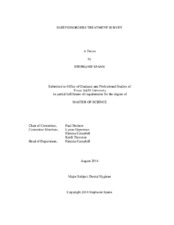| dc.description.abstract | Even though the Association of Sleep Disorders Center was founded in 1976, sleep medicine wasn’t considered a specialty until 1996. The United States population has undergone a 20% decrease in sleep time over the past century, with a concurrent increase in reported sleep disorders. Sleep disorders are similar to the “silent killer” heart disease in that they frequently go undiagnosed. While personal health can be affected by sleep disorders, there is also a risk to third parties. Big trucks are responsible for 4,000 fatalities yearly, and 28% of commercial driver’s license (CDL) drivers have diagnosed sleep apnea. A government passed bill HR3095 regulates physical exams required by CDL drivers. A licensed CDL driver now has to be seen by a medical examiner registered by the National Registry of Certified Medical Examiners to be eligible to drive once diagnosed with a sleep disorder. Several treatments are offered to alleviate the symptoms of sleep disorders. The standard form of treatment requires patients to wear devices that often result in low compliance. However, it is unclear what types of treatments patients try, and whether they eventually find a treatment that works to alleviate their symptoms.
This study was performed on 86 subjects to obtain a census of what treatments people who had been diagnosed with sleep disorders used to alleviate their symptoms. There are no current cures for sleep disorders but the symptoms can be managed. This survey assesses patient knowledge and where they acquired their information about sleep disorders and treatment, which treatments were used, what symptoms were experienced, and quality of life issues. The majority of subjects acquired their information about sleep disorders from their dentists, sleep physician, family doctor, family/friends and the internet (94%). Over 76% of the subjects stated that they had sleep disordered breathing symptoms for 6 years or more. There were several modalities of treatments used; nonsurgical, surgical and pharmacological. The two preferred treatments of choice were continuous positive airway pressure (CPAP) machines and adjustable oral appliances (aOA). Subjects used aOA (80.2%) more often than CPAP (11.6%). Mann Whitney U-tests showed significantly fewer traveling difficulties and less interference with their quality of life with aOA than CPAP use. There was significant improvement after treatment in snoring, fatigue, and feeling refreshed in the morning regardless of treatment modality. | en |


